Peptides are a hot topic in skincare right now, but do you really understand what they can do for your skin? Retinol is another popular ingredient that’s been around for decades. But which one should you use to get the best results?
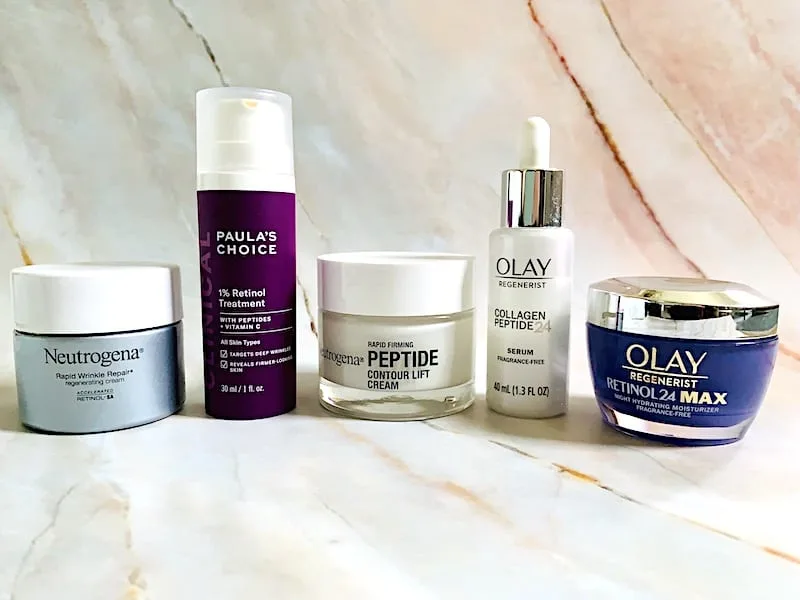
This post contains affiliate links, and any purchases made through these links will result in a commission for me at no extra cost to you. Please read my Disclosure for additional information.
In this post, I’ll break down retinol vs peptides, how each ingredient works and for what skin types they might be most effective.
You’ll learn about their benefits, side effects, and more so that you can make an informed decision on which product will work best for your unique complexion.
Peptides are amino acids that help build collagen and firm the skin. This helps to reduce the look of wrinkles and fine lines and improve skin elasticity.
Retinol is a form of vitamin A and a powerful cell-communicating active. It improves cell turnover, helping to reduce wrinkles, fine lines, hyperpigmentation, dark spots, and other signs of aging.
Let’s take a look at the benefits and varieties of retinoids (retinol is a retinoid) and peptides.
Jump Ahead To:
The Benefits of Peptides in Skincare
Common proteins found in the skin include keratin, elastin, and collagen, which give the skin its strength and structure and helps the skin rebuild itself.
Peptides are short chains of amino acids, which are the building blocks of these proteins. So peptides are often found in skincare products that are designed to fight skin aging.
Peptides work by signaling cells to carry out specific tasks, like producing more collagen. Increased collagen levels can help reduce fine lines and wrinkles and improve skin elasticity and firmness.
Peptides help improve overall skin health and keep the skin looking youthful.
Luckily, we can apply peptides topically to help stimulate collagen production for firmer skin with fewer wrinkles.
Peptides are named for their chemical structure of amino acids (like di-, tri-, and penta-peptides). Common types of peptides used in anti-aging serums, creams, and other skincare products include:
- Palmitoyl Pentapeptide-4: This peptide, also known as Matrixyl, from P&G (Olay’s parent company) and Sederma is a subfragment of type I collagen. Manufacturer-sponsored research shows that this peptide helps to smooth fine lines and wrinkles.
- Palmitoyl Tripeptide & Palmitoyl Tetrapeptide-7: This peptide duo is known under the brand name Matrixyl 3000. This duo works to reduce wrinkles, skin roughness and improve elasticity.
- Palmitoyl Tripeptide-38: This peptide (found in Matrixyl Synthe’6), per the manufacturer, increases the production of six elements of the skin matrix. It targets wrinkles, crow’s feet and forehead wrinkles.
- Argireline: Contains the peptide Acetyl Hexapeptide-8 that mimics the effects of Botulinum neurotoxins (Botox) on wrinkles without the unwanted side effects. It is not as strong and doesn’t last as long as Botox, as it is just a temporary fix.
- Copper Peptides: Copper peptides are a special type of peptide joined with copper that is believed to help the skin produce more collagen, strengthen the elastin tissue, and reduce inflammation. Copper peptides are also supposed to improve skin firmness, reduce the look of hyperpigmentation, and offer wound healing and antioxidant benefits.
The Benefits of Retinol in Skincare
Retinol (vitamin A) is well known for its ability to fight the signs of aging, thanks to its ability to stimulate collagen synthesis. Retinol helps soften lines and wrinkles, reduce age spots, smooth skin texture, fade hyperpigmentation, and increase collagen production.
Retinol also improves cell turnover rate by revealing newer, healthier layers of skin. In this way, retinol can also help to treat acne and strengthen the skin’s barrier function.
Retinol may be too harsh for sensitive skin types, so look for newer retinoids like retinol esters for gentler formulations.
The main types of retinoids from strongest to weakest:
Retinol is a type of retinoid that needs two conversions in your skin for it to become active. First, it converts to retinaldehyde and then to retinoic acid, which is the form that can be used in the skin.
This process makes retinol less potent than some other retinoid skin treatments like the prescription retinoid tretinoin (Retin-A), as the conversion process reduces retinol’s effectiveness.
But because it’s less potent than these prescription retinoids, retinol is less likely to cause skin irritation, redness, and peeling.
- Tazarotene (Tazorac): Prescription-strength synthetic retinoid used to treat acne and psoriasis. While shown to be more effective at treating acne than tretinoin, it is also more irritating than tretinoin.
- Tretinoin (Retin-A): This prescription-strength retinoid, also known as all-trans-retinoic acid, is available as retinoic acid in the skin so no conversion is needed to be active in the skin. It is used to treat acne and the visible signs of aging like wrinkles, fine lines, and photodamage from UV radiation .
- Adapalene: Available over-the-counter as Differin and now also offered by La-Roche-Posay and Proactiv, adapalene has been mainly studied in the treatment of acne and is less likely to cause irritation than tretinoin but also less effective.
- Retinaldehyde, Retinyl Retinoate, Hydroxypinacolone Retinoate: These retinoids need one conversion to become active in the skin, so they will usually provide quicker and better results than retinol.
- Retinol: The most popular over-the-counter retinoid that needs two conversions to become active in the skin.
- Retinyl Esters: Retinyl palmitate, retinyl acetate, and retinyl propionate are some retinyl esters that are less potent than retinol, as they need three conversions to become active in the skin. They are also the less irritating than retinol.
NOTE: Retinol can make your skin more sensitive to the sun, so it is important to use a sunscreen that protects against UVA and UVB rays every day (not just when you’re going to be outdoors).
So don’t forget to apply a broad-spectrum sunscreen that contains an SPF of 30 or higher.
Retinol vs Peptides: Skin Type
If you have dry, sensitive skin, peptides might be the better choice because it helps with collagen production without causing additional dryness, redness, irritation and/or peeling.
Retinol is excellent for most other skin types because it brightens, firms, and smoothes the skin, helping to even out skin tone and texture.
Retinol may also be extra helpful for those with combination, oily and acne-prone skin, as it exfoliates dead skin cells and helps unclog pores.
Retinol vs Peptides: Which is Better?
Retinol is the gold standard in over-the-counter anti-aging products. Retinol can be more effective than peptides at treating the visible signs of aging like deeper wrinkles, hyperpigmentation and dark spots, and lack of elasticity and firmness.
Peptides are often the better option for those who want to prevent signs of aging and to keep the skin firm and youthful.
Peptides are great actives to add to your toolbox and can be effective when used with other treatments, including retinol.
THE BOTTOM LINE: Peptides are a great way to fight aging, but they’re not as effective as retinol. Retinol is an ingredient that has been around for decades, and it generally works better than most other over-the-counter anti-aging products on the market today.
Retinol can help with fine lines, wrinkles, dark spots, and more.
If you want younger-looking skin without having to spend thousands of dollars on laser treatments or injections, then retinol is the ideal choice to add to your skincare routine.
Retinol and Peptides Together
Depending on the formulations of the products, you might even be able to use retinol and peptides together. (I usually apply my retinol serum first and then follow with a peptide serum.)
Or, you can use a 2-in-1 retinol serum with peptides (see below).
Peptide and Retinol Skincare Product Picks
If you are unsure whether you want to try peptides or retinol, Paula’s Choice offers a potent skincare product that contains BOTH peptides and retinol:
Paula’s Choice Clinical 1% Retinol Treatment
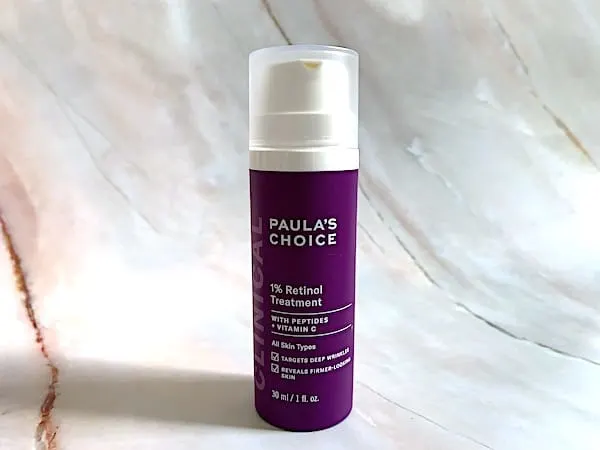
Paula’s Choice Clinical 1% Retinol Treatment contains one of the highest concentrations of pure retinol allowed in an over-the-counter product. It targets fine lines, wrinkles, and uneven skin tone.
The treatment is enriched with many skin-loving ingredients, including palmitoyl tripeptide-1 and tetrapeptide-7, the anti-aging duo Matrixyl 3000, palmitoyl hexapeptide-12 (a six amino acid peptide that works to increase skin firmness and skin tone), and acetyl dipeptide-1 cetyl ester (a soothing dipeptide).
Licorice root extract brightens the skin and soothes irritation, and calms redness. Tetrahexyldecyl ascorbate, a vitamin C derivative, offers antioxidant protection against free radical damage.
Oat extract and burdock root extract are antioxidants that soothe the skin. Allantoin also calms the skin. Sodium hyaluronate (the sodium salt of hyaluronic acid) hydrates and plumps the skin.
This retinol treatment comes in the form of a lightweight lotion.
Paula’s Choice recommends using this retinol treatment no more than three times a week and then slowly increasing usage to every other night and then nightly IF tolerated.
Paula’s Choice also notes that it is possible to experience delayed sensitization to this retinol treatment, including redness, flaking, and dryness.
If you don’t see a reaction after a few uses, you can use it more frequently.
Olay Collage Peptide 24 MAX Serum
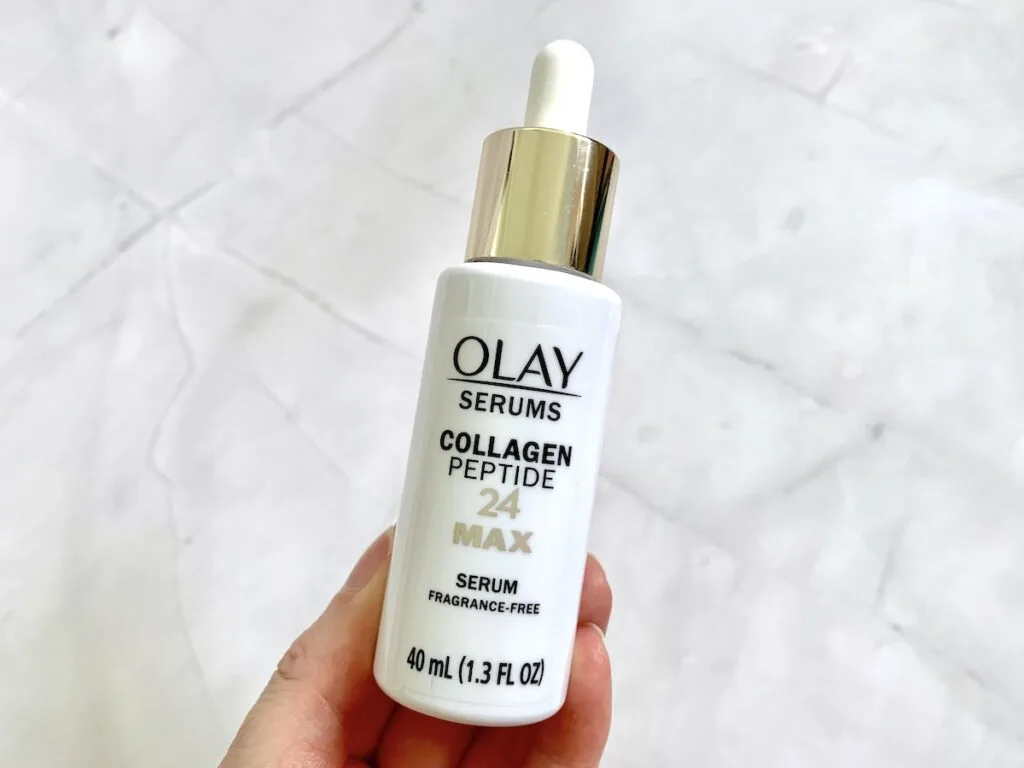
Olay Collage Peptide MAX 24 Serum is a fragrance-free serum formulated to provide up to 24 hours of hydration thanks to niacinamide and Olay’s proprietary Collagen Peptide. The serum tightens, softens, and firms the skin.
This MAX formula contains twice as much Collagen Peptide vs the base Collagen Peptide 24 formula.
Niacinamide helps skin retain moisture and strengthens the skin barrier. It also improves cell turnover to gently exfoliate dead skin cells and smoothes fine lines and wrinkles.
Glycerin and panthenol moisturize the skin.
Palmitoyl Pentapeptide-4, as noted earlier, helps reduce the look of wrinkles and fine lines and supports the skin’s natural renewal processes for younger-looking skin.
If you like Olay products and are looking for a gentle and non-irritating anti-aging moisturizer, Olay also offers Regenerist Collagen Peptide 24 MAX Face Moisturizer, which you can use in conjunction with this peptide serum.
Neutrogena Rapid Firming Peptide Contour Lift Face Cream
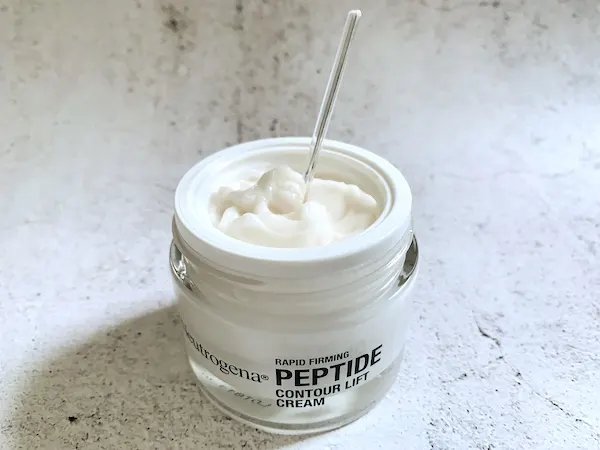
Neutrogena Rapid Firming Peptide Contour Lift Face Cream contains acetyl dipeptide-31 amide to firm the skin and improve skin elasticity.
The micropeptide was formulated to travel deep within the skin’s surface to work on skin that has lost collagen and elastin.
The cream is enriched with chemical exfoliants, like alpha hydroxy acid (AHA) glycolic acid, to remove dead skin cells and stimulate collagen production for firmer skin.
It also contains gluconolactone, a polyhydroxy acid (PHA), that offers a more gentle exfoliation than glycolic acid and moisturizes the skin, strengthening the skin barrier.
Glycerin and squalane provide additional moisture to the skin.
CeraVe Resurfacing Retinol Serum
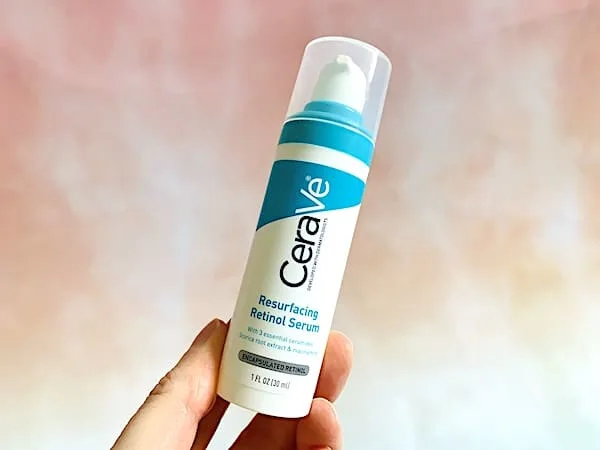
CeraVe Resurfacing Retinol Serum targets uneven skin tone, acne scars from post-inflammatory hyperpigmentation, and enlarged pores, all while protecting the skin barrier.
The serum increases cell turnover to resurface the skin with a form of encapsulated retinol released slowly for reduced irritation.
Niacinamide (Vitamin B3) offers multiple benefits for the skin. It has anti-inflammatory benefits, enhances surface hydration, smoothes fine lines and wrinkles, fades hyperpigmentation and dark spots, and helps to visibly reduce the appearance of enlarged pores.
Licorice root brightens the skin, and CeraVe’s proprietary three essential ceramides moisturize and support a strong skin barrier.
Phytosphingosine is a lipid that is helpful in the treatment of acne.
Although the amount of retinol is not disclosed, this retinoid serum is a good choice for those new to retinol since the formula lists retinol as low on the list of concentrated ingredients.
The serum is lightweight and fast-absorbing and uses CeraVe’s MVE Technology to continually release moisturizing ingredients for long-lasting hydration.
Olay Regenerist Retinol 24 Max Moisturizer
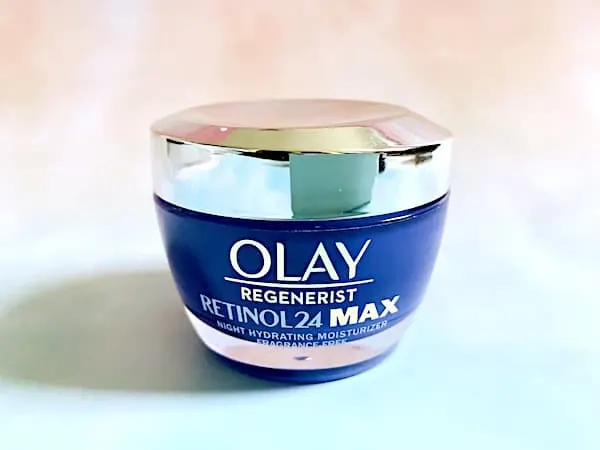
Olay Regenerist Retinol 24 Max Moisturizer is another affordable drugstore retinol option that contains retinol and peptides to transform the look of skin.
The fragrance-free formula contains the maximum concentration of Retinol 24’s hydrators to replenish skin. It also contains 20% more Retinol 24 Hydrating Complex when compared to the original Retinol 24 moisturizer.
The cream works to smooth wrinkles and improve skin tone with two retinoids: retinol and retinyl propionate.
It also contains brightening and anti-inflammatory niacinamide and Olay’s collagen peptide, palmitoyl pentapeptide-4, for additional anti-aging benefits.
This cream leaves your skin silky soft while refining skin texture and reducing the look of enlarged pores and dark spots.
While the cream is suitable for normal, oily, and combination skin, those with dry skin will appreciate the extra hydrating benefits from glycerin and niacinamide.
Retinol vs Peptides
When it comes to retinol vs peptides, retinol is the more potent ingredient that is effective in reducing wrinkles, dark spots, and skin tone.
The downside of retinol and other retinoids is that they can cause dryness or irritation for those with sensitive skin.
Peptides may not produce as many effects on your skin but have a gentler effect overall compared to retinol, which is well known for causing irritation, dryness, and redness.
Your best bet might be combining retinol with peptides, in products like Paula’s Choice Clinical 1% Retinol Treatment or Olay Regenerist Retinol 24 Max Moisturizer, to get the benefits of both ingredients. Just be sure to start slow with low retinol concentrations, and work your way up if needed.
Thanks for reading, and until next time… here’s to your good skin health!
Read Next: Drmtlgy Review
